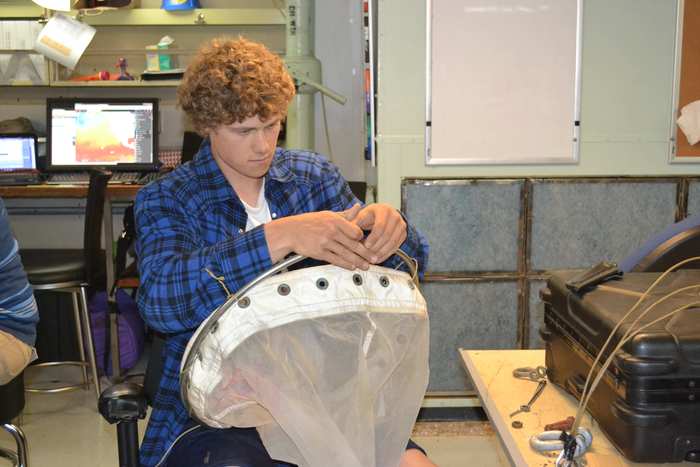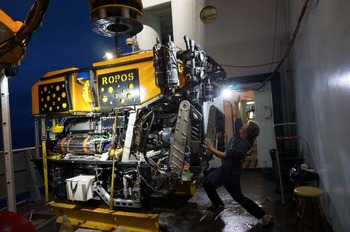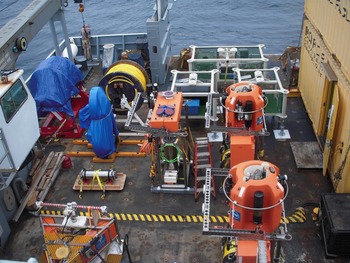My sleep schedule is pretty off, which is fine because time is almost an illusion while out at sea. I’m sure that I have heard someone tell me good morning at every hour of the day now.
July 16
Everything has been going wonderfully at sea this year! Perfect weather has allowed us to stay right on schedule and thankfully nothing has gone wrong regarding installation and repairs. The students have been absorbing as much information as possible, arranging meetings with one or more of the crew, scientists, or engineers each day in order to obtain a better understanding of the various activities of the ship. Listening to all of their tales has been inspiring and humbling. Many times, we end up discussing life stories, and most of the people on the Thompson have quite the life stories. Dana, one of the crew on board, presented us a slideshow of some of the most incredible underwater photography I’ve ever seen. She goes scuba diving all over the world, the Galapagos, Papa New Guinea, Australia, you name it. One of the two marine techs named Ken spent two hours explaining how he got to where he is now. Hearing his stories of world travel and spontaneous adventures had me yearning for foreign journeys. Deb has been gracious enough to share with us her extensive knowledge of everything marine, allowing us to have a hydrothermal vent talk from one of the greats in oceanography.
I decided to create a geology video as an additional project. Once I saw other students working on video projects, I remembered how much I love creating them as well. At first, I wanted to make an intense video about the collapse zones and phenomenal pillars that are created as lakes of undersea lava are transformed into beautiful caves due to the waters cooling effect on the tops of the structures. An outer crust forms and the lava contained drained out creating these incredible formations. As I delved into a script, however, I realized that I wanted to write about more than just these specific formations. So, I am almost completed with a script about a much more generalized geology of the Axial volcano, discussing briefly the various ways that the lava produces the amazing structures of the deep. Before the end of the cruise, I am most likely only going to be able to finish writing the script, getting a rough recording of it, and finding some music to go along with it. Matching footage with the audio will be a task I can do back on land over the summer or during fall quarter.
Currently, we are in transit to Southern Hydrate Ridge, which is much closer to land that Axial Seamount, where we have been for the past week and a half. Sadly, we didn’t have the time to test out my deep sea zooplankton net while we were over any of the hydrothermal vent fields because we did very few CTD casts in the area. I am going to try to attach the net to the CTD once we arrive at Hydrate Ridge tomorrow morning to look at the effect of methane seeps on zooplankton abundances. Similar to what I was hoping to look at around the vent fields, I will be trying to sample with the net tow at discrete depth layers to determine if methane increases zooplankton populations at certain depths. Also, because Hydrate Ridge is a much shallower site, I will be able to use the Acoustic Doppler Current Profiler (ADCP) attached to the bottom of the R/V Thompson to help see zooplankton with sonar. I wouldn’t have been able to use this device at Axial Seamount because its depth is greater than the range of the instrument. Using sonar will be extremely helpful to look at zooplanktons on a grand scale, because the net tow will only sample a small number of them.
Last night many of the students stayed up for sunrise working with the CTD to help calibrate the shallow water profilers, which monitor various water properties throughout the upper 200 meters of the water column. My sleep schedule is pretty off, which is fine because time is almost an illusion while out at sea. I’m sure that I have heard someone tell me good morning at every hour of the day now. We were able to break the monotony for some of the CTD casts, though, keeping us awake and interested. For the cast that went the deepest, most of the students colored cups and tied them in a mesh bag to the frame, which shrunk the cups to about a quarter of their original size. Also, we took a large amount of water from the sea floor and put it in a large pot to cook it down for salt! Hopefully the salt will be ready to eat by tomorrow which should be interesting to try.
July 10
Yesterday, ROPOS took some of the most amazing footage I have ever been fortunate to see, let alone be a part of. Cam-HD, the name of the deep sea HD camera, was placed adjacent to a hydrothermal vent name Mushroom, and while its lights were illuminating Mushroom, ROPOS flew around the vent to gather phenomenal imagery during testing of the camera. I only got about 2 hours of sleep over a 40 hour period because I wanted to watch as much of the dive as possible, along with finishing my other shipboard responsibilities.
Now that we have been making dives over hydrothermal vents, I have begun gathering data for my project regarding hydrothermal plumes’ effect on zooplankton populations. I am recording the sonar data on ROPOS and gathering descent and ascent footage to see if I can visually detect zooplankton. Sadly, it will be difficult to determine if I come up with anything conclusive until after I have come back to shore. Much of the software I need to accomplish my analysis is unavailable to me while on board. This makes for many tough decisions because I have to get all of the data while I am out at sea, but I can’t know what parameters are most effective until I am already off the ship. Thankfully, the experts out here with me are helping me to figure out what might be best.
July 7
Day four out here at sea! It feels good to get back in the swing of ship life, with ridiculous amounts of food and hard-working scientists and engineers who say they sleep sometimes, but I often doubt it. We arrived on site the night of the 5th and since then, ROPOS and the CTD have been taking turns in the water. The weather out here couldn’t be better for the mission: the swells have been a meter or less for the past day which has allowed ROPOS to easily function with the large packages it has had to carry with it. The only setbacks thus far have been a minor pressurization problem with ROPOS, which brought the remotely operated vehicle back on board for a couple hours, and a bow thruster that wasn’t working for a little while, making it difficult to stay at a certain location. Thankfully, whenever ROPOS was on deck, the CTD was cast to obtain water samples and take measurements.
Katie and I have begun to make the finishing touches for the biology catalog that will hopefully be up on the website soon. Or at least, what we thought were the finishing touches. After looking through the pages and creating a to-do list, it turns out there is a little bit more than we anticipated, which will keep us busy. In the middle of writing this, a huge pod of porpoises was spotted off the bow which was beautiful to watch! For the most part, the pod kept a bit of distance from the ship, but two of the animals came close to play and gave us a show 10 meters off the bow.
After one more ROPOS dive, the ship will transit from our current location at Slope Base, which is about 60 miles off shore, to Axial Seamount, 300 miles out from Newport. I am excited (and nervous) to start attempting to gather zooplankton data around the hydrothermal systems. Hopefully my net will work as planned, getting samples at discrete depth layers around the plume to determine if zooplankton populations are affected by the nutrients and bacteria associated with the vents. Sadly, I found out that the sonar system on ROPOS only goes up to 220 kHz, which is low for detecting zooplankton. I am still going to try to see what data I can gather with it, as I may be able to determine the presence of groups of animals even if I can’t pick up the signal from the individual organisms themselves.
July 5
It’s been almost a year since I sailed with the Thompson, and it feels great to be back on board! So far, the vessel has been fairly relaxed since we have been transiting for the past day, but it should pick up in intensity once we arrive on site tonight. Tonight I have the 20:00 to 24:00 watch, but I will also be the trainer for the 00:00 to 04:00 watch, so it will be a long night. On most days, I only have watch from 20:00 to 24:00.
The next couple of weeks are going to be very excited, as I am going to begin gathering data for my senior thesis project, for which I want to examine the interconnected relationship between hydrothermal venting, zooplankton abundance, and whale migration. Zooplankton are known to migrate vertically throughout the water column, but for a long time they were thought to have stayed within the upper 800-900 meters. However, when data began to indicate that zooplankton biomass was higher over active venting regions, this commonly held belief was reexamined and determined to be false. The hydrothermal plume generally spreads out horizontally not far off bottom, meaning that zooplankton would have to migrate much deeper to be affected by it. Studies have since found zooplankton to exist in great abundance directly above the hydrothermal plume, likely feeding on the bacteria associated with the plume. Because zooplankton are a major food source for whales, it has been hypothesized that whales spend more time above venting regions than in the general open ocean. William Wilcock, a professor at the University of Washington, has found data agreeing with this theory at the Endeavor vent fields off of Vancouver Isand, but the relationship has yet to be examined around Axial Seamount, which is what I hope to look at over the next year.
During this cruise, I will mostly be gathering data about the distribution and abundance of zooplankton at the vent fields around Axial. I plan to gather samples with net tows, use sonar to detect their presence, and inspect footage with visual editing software to find where zooplankton are residing. Over the following year, I can analyze this data and relate it to whale migratory patterns to determine any correlations. I will be able to determine the presence and location of the whales by using seismometers. Yes, the very same instruments that measure earthquakes! Whales vocalize in a frequency range that seismometers can detect up to about 15 to 20 km away, so I will be able to figure out their position and travel direction by triangulating their calls. Analyzing the whale data is not as pertinent on this cruise, however, because the information will be available at any point when I return.




